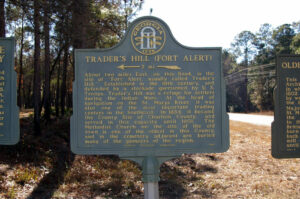This week’s #MarkerMonday highlights the Trader’s Hill (Fort Alert) historical marker in Charlton County. Trader’s Hill was a small community settled around 1755 at the head of navigation on the St. Marys River in present-day Charlton County. The community’s location on the St. Marys River allowed for Trader’s Hill to become one the most important trading centers in the Southeast, where items such as cotton, beeswax, honey, jerky, and hides were traded. The community also became an important center for cultural trade in the region.
Trader’s Hill is located in Georgia’s Okefenokee Swamp region. Settled primarily by families of Scottish or Scotch-Irish descent, who migrated from Florida and the Carolinas, the region was influenced by Celtic traditions. The Celtic settlers in this area made their living from agriculture, livestock herding, and naval stores. These rural settlers were often referred to as “crackers,” which linguists believe originates from the Gaelic root “craic,” which is used in Ireland to mean an “enjoyable social activity.” However, “cracker” began to be used to mean a braggart, boaster, and lawless White person in England and America. The term was used mostly as a derogatory term that carried a stereotype, as many of the antebellum aristocrats felt that these non-elite, self-sufficient rural groups were not only lower class, but invaders and outsiders to the more “civilized” Georgians.
Today, Trader’s Hill is a ghost town. However, the Celtic settlers of this region helped shape the traditions in the area, including folk storytelling, traditional foods, beekeeping, and music traditions such as Sacred Harp singing.
Explore the links below to learn more:
New Georgia Encyclopedia - Human History of the Okefenokee Swamp
New Georgia Encyclopedia - Okefenokee Swamp Folklore
New Georgia Encyclopedia - Crackers
GHS houses several collections related to Trader's Hill and the Okefenokee Swamp.
History of Charlton County/by Alex. S. McQueen; with new index by Margaret H. Cannon.
Plus many more.
The Georgia Historical Quarterly has published several articles relating to Trader’s Hill, Fort Alert, the Okefenokee Region, and Cracker Culture, which can be accessed on JSTOR. If your library does not have access to JSTOR, you can go to www.jstor.org and create a free MyJSTOR Account.
Presley, Delma E. “The Crackers of Georgia.” The Georgia Historical Quarterly 60, no. 2 (1976): 102–16. http://www.jstor.org/stable/40580269.
Denham, James M. “‘A Most Profligate Villain’: Poor Whites as Depicted in Antebellum Wanted Proclamations.” The Georgia Historical Quarterly 101, no. 4 (2017): 300–318. http://www.jstor.org/stable/44651754.
Coulter, E. Merton. “The Okefenokee Swamp, Its History And Legends.” The Georgia Historical Quarterly 48, no. 2 (1964): 166–92. http://www.jstor.org/stable/40578461.
Coulter, E. Merton. “The Okefenokee Swamp: Its History and Legends, Part II.” The Georgia Historical Quarterly 48, no. 3 (1964): 291–312. http://www.jstor.org/stable/40578402.
Thomason, Hugh M. “Governor Peter Early and The Creek Indian Frontier, 1813-1815.” The Georgia Historical Quarterly 45, no. 3 (1961): 223–37. http://www.jstor.org/stable/40578144.
Plus many more.

